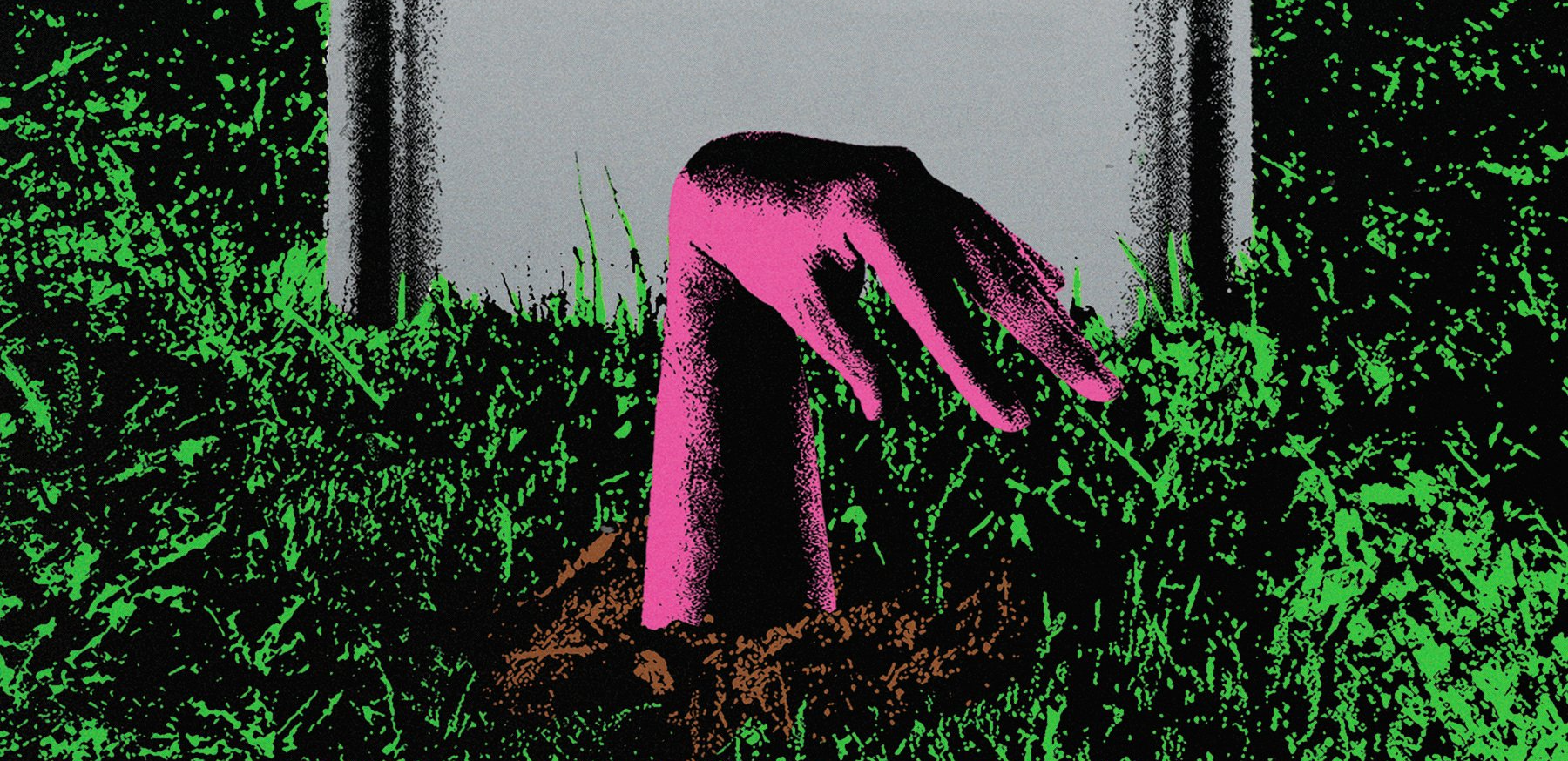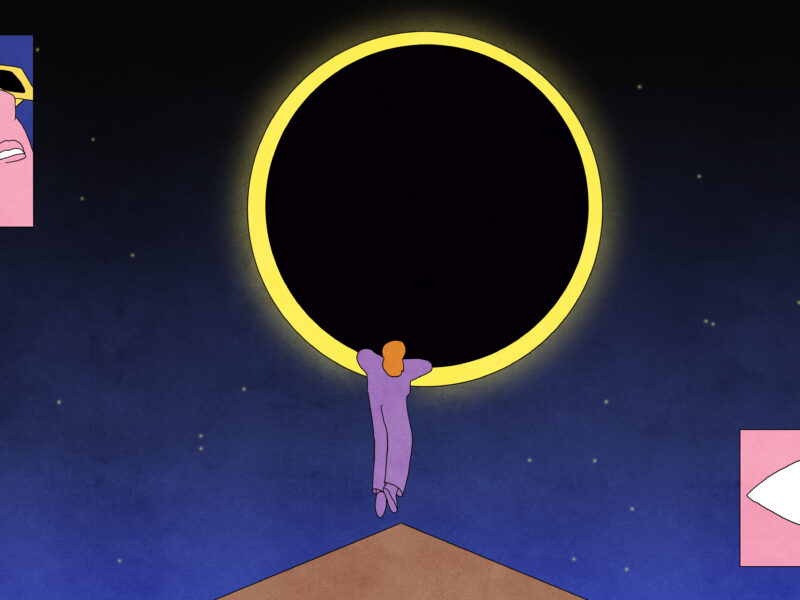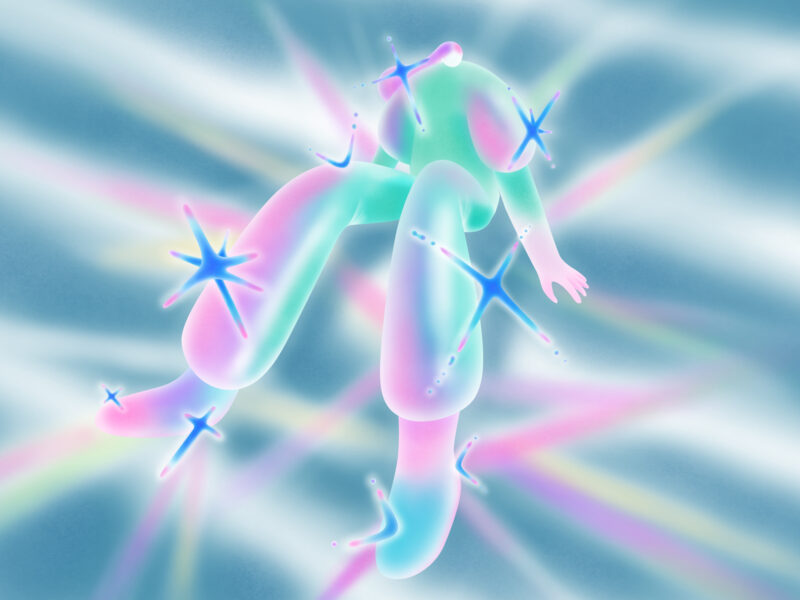An exclusive excerpt from “It Came from the Closet: Queer Reflections on Horror.”
In My Skin / Dans ma peau
IT WASN’T UNTIL I got pregnant that I finally saw how distant I was from my own body. This was late 2016, early 2017, and I was about to turn thirty-five, a late age for a first baby. I spent half my day reading pregnancy manuals and websites, baffled and embarrassed by their maniacally chipper tone, which seemed to be aimed not at parents of small children but at the actual children themselves: Baby is the size of a grape! A papaya! A spaghetti squash! It’s all right to be nervous. But more all right to be happy! Mom (the pregnant person is always addressed, in these texts, as “Mom”) is getting ready for a big change!
I was not getting ready for a big change, I was in the midst of one. My personality shifted with my hormones, giving me new tastes and interests and a terrifying ability to cry in public. I swelled and rounded, changed shirt sizes and pant sizes and shoe sizes, puffed up at the joints until I had the tree-trunk legs of a brontosaurus. In the more scientific manuals, I learned that my body had doubled its amount of blood; that the baby’s cells were mingling with mine, and would stay there after I gave birth, rendering me a biological chimera; that I was growing a new organ, the placenta, and when I gave birth, I would both expel and (the manuals strongly encouraged) eat it.
The teenage edgelord in me delighted in this information. A parasite turns you into a mutant and forces you to eat your own organs; what’s cooler than that? Yet, when I tried to talk to other people about how disgusting pregnancy was, I was met with baffled politeness, not only from the world at large but from pregnant women. This experience of being lost at sea in my own body, held captive to its processes, seemed to be mine alone. In fact, if the expressions on people’s faces were any indication, it was mildly crazy.
Yet the more I sat with the feeling, the more it seemed to me that my body had never belonged to me. There were whole areas—my hair, my breasts—that I was keeping around primarily because they got a reaction from people. There were processes that had always felt unwelcome; as a teenager, my periods were so distressing that I once passed out in the middle of a McDonalds because I felt one coming on. I could never figure out all the little things women were supposed to do, how it was that they managed to look adult and female and put-together. It seemed easy, or at least manageable; a necessary life skill, like cooking dinner. I just couldn’t do it. My body was something I needed to manipulate, a weird, soft machine I was never quite sure of operating correctly. I fed it like a pet, washed it like a car, exercised it… well, no, I didn’t exercise it, because that would require getting in there and fucking around, and I spent as much time reading or drinking or otherwise getting out of my body as I could.
It never would have occurred to me to call these feelings “dysphoria.” I pushed through them the same way I’d always pushed through the pangs of shame and panic I got when I tried to do girly things or present as convincingly feminine, telling myself it was just internalized misogyny or poor self-esteem. Yet it seems clear to me now that my pregnancy was the beginning of my coming-out process as a nonbinary transmasculine person. It called my body to my attention. It made me realize that I could successfully and intentionally undergo a big change.
Now that I’m out, my former alienation from my body seems normal. I wasn’t “put together” because I was trying to put together the wrong thing. It’s like I bought a coffee table at IKEA and spent thirty-five years trying to assemble a couch with the parts. Frustration was inevitable. Yet in the moment, before I knew any other name for my experiences, my only comparison was body horror—specifically, the body horror movie I loved most in the world, and have loved ever since I saw a crappy VHS copy of it in college: In My Skin, the 2002 independent movie by French writer-director Marina de Van. In My Skin (Dans ma peau) is one of those movies that frequently makes lists of the “most disturbing movies ever” or “toughest horror movies to watch.” The college boyfriend I rented it with noped-out by the second act, telling me he was just too uncomfortable to keep going. I’ve always enjoyed the nerdy flex of watching a horror movie that is too much for some cis guy, and yet it pains me that In My Skin is remembered primarily as a gross-out feature. The violence here is nowhere near as graphic as the average Saw or Hostel movie. In My Skin is scarier than those movies precisely because it reaches the viewer on a level that soulless splatter porn can’t; the injuries feel real and painful because they’re grounded in a frighteningly believable portrait of one woman’s self-destruction.
We open on a heroine, Esther (played by de Van, directing herself), who seems to more or less have her life together: she’s got a job at an advertising firm, with a promotion in the near future; she has a boyfriend who wants to move in together; she’s putting him off, but it seems clear where things are headed. It’s a recognizable white, upper middle-class, postfeminist, heterosexual trajectory. It’s what she’s supposed to want, even if some key elements, like the boyfriend, don’t excite her as much as she’d like.
One night, at a drunken party, Esther manages to rip her calf open on a piece of jagged metal in someone’s yard. Due to some combination of shock and nerve damage and alcohol, Esther doesn’t feel the injury, and goes through the whole night without realizing that her leg is gushing blood. She only sees what’s happened when she goes to the bathroom; she gasps, and fingers the edges of her wound, and begins crying. It’s not clear whether she’s in pain or simply horrified by what she’s seeing.
I mean to say: Esther is betrayed and traumatized to see her body shedding blood from a hole that shouldn’t be there. You can see where the transmasculine viewer might connect. It is also bizarrely relatable to see how Esther tries to deal with the injury, which is, at first, by pretending she doesn’t have one; she goes over to her friends and casually mentions that she might need to go to the hospital, but she wants to stop at a bar for one last drink first. The doctor who eventually stitches Esther up is baffled by her dissociation: “Are you sure it’s your leg?” he jokes.
Esther doesn’t laugh. She also doesn’t answer. Esther becomes obsessed with her injury, and with the numbness that seems to be spreading out over her whole body. She begins trying to re-create the thrill of getting hurt; first pinching and picking at herself, then cutting herself, then doing several things so gross that one hesitates to spoil them, except to say that this one woman somehow becomes both the perpetrator and the victim of an entire Texas Chainsaw Massacre before the credits roll.
The gross-outs are real, but never cheap. Esther’s self-harm addiction mounts slowly and realistically; the brief relief of a cutting session in the break room slowly giving way to more sessions, more extreme injuries, entire weekends spent alone in a hotel room, doing things to yourself that you have to explain later as the result of a car accident. Some scenes are uncomfortable precisely because de Van’s slack-jawed, compulsive pleasure as she works on herself feels like watching someone masturbate. It’s that kind of problem: an urge you can’t get rid of without indulging, a gross but pressing need.
Esther’s self-destruction is a symptom of alienation: from capitalism (during a business dinner, Esther has to forcibly restrain her hand from skittering around the table) or from womanhood (after one cutting session, she watches a female friend apply moisturizer, baffled by the concept of feminine self-care) or from heterosexuality (her boyfriend tries to “cure” her by fucking her while asking if she can feel him; he does not get the answer he’s hoping for). Careful viewers will have noted that de Van’s heroine shares a name with Esther Greenwood, the protagonist of Sylvia Plath’s novel The Bell Jar. Like that other Esther, she self-destructs in part because meeting the expectations placed on women already feels like a kind of self-harm.
Most importantly, though, the cutting is symptomatic of Esther’s alienation from Esther. She doesn’t hate her body, she tells us, but she also doesn’t think of it as her. Her self-injury is exploratory, almost clinical; she’s a scientist, testing the foreign object of her flesh, trying to see what it can do. In fact, there is no part of Esther’s life that is truly hers: her friends are not really her friends, the man she fucks isn’t someone she particularly wants to be fucking, her professional success is maintained at the cost of disappearing into back rooms and wine cellars and coming apart at the seams. She takes her body apart because she is trying to get back inside it. She’s not trying to kill herself. She’s trying to prove she’s alive.
~
It’s dangerous, I know, to connect transmasculinity or gender dysphoria with a movie about female self-mutilation. The idea that transmasculine people are self-harming “women” is currently one of the main talking points TERFs (trans-exclusionary radical feminists) use to try to argue us out of existence.
As I write this, the number one book result on Amazon for “trans men” is a book called Irreversible Damage. The title is splashed across the page in big, bloodred letters, with a subtitle promising to expose the “Transgender Craze That’s Seducing Our Daughters” in the same tone 1950s horror movie posters used to advertise a “Terrifying Monster of the Ages!” or some “Students Made Victims of Terror-Beast!” Beneath the titles, there’s an illustration of a little girl, or possibly a baby doll, who is still alive and conscious despite the gigantic, red-rimmed, perfectly circular hole scooped out of her stomach.
The message is clear: transmasculinity is body horror. The average trans boy, according to Irreversible Damage author Abigail Shrier, is “psychologically alienated from her [sic] own body, and headed toward medical self-harm;” she predicts that medical transition will leave such a boy “angry, regretful, maimed, and sterile.” Give or take a “sterile,” he sounds very much like Esther from In My Skin.
Other TERFs have resorted to putting transmasculine bodies on display, hoping that the supposed freakishness of top surgery scars or testosterone-squared jawlines will scare the public away from supporting us. Photographer Laura Dodsworth has published an entire series of seminude portraits of “detransitioners,” women who formerly identified as transmasculine. Dodsworth was inspired, she says, by the horror she feels when she thinks about trans men’s bodies: “For me, the idea of having my breasts, ovaries, and womb removed, and then wanting them back, creates a feeling so unnerving that I cannot occupy it for long.”
She can, however, ask other people to occupy it in front of her while she takes pictures. It’s not clear whether Dodsworth informed her subjects that she would accompany the photos of their naked bodies with commentary on how scary and disgusting they are; nor is it clear how Dodsworth’s “unnerved” feeling is different from the pleasurable disgust carnival-goers feel at freak shows.
First things first: The posttransition body is not a mutilated body. It’s a healed body. Transition is not a symptom of psychological distress but a means to cure it. That “unnerving” feeling Dodsworth imagines—the horror of looking down at a body you don’t recognize, one which can’t do what you want or need it to do—is already felt by many people who are uncomfortable in their assigned genders, and it is spectacularly cruel for someone to use her own imaginary dysphoria as an excuse to deny transpeople treatment for theirs.
Yet the rubbernecking dread transphobic “feminists” have for trans bodies—Shrier, or Dodsworth, or J. K. Rowling, for whom trans boys are merely psychologically damaged and self-hating “girls” who’ve succumbed to the “allure of escaping womanhood”—is not unfamiliar to me as a horror fan. Whether these women know it or not, they’re talking about transpeople in the same way that sexist men have historically talked about the bodies of cis women.
The body horror genre is deeply rooted in cis men’s fear of femininity, and considers cis female bodies to be inherently freakish, flawed, and deformed. In particular, body horror often focuses an obsessive disgust on cis women’s reproductive cycle, either in a sideways fashion—like the exceptionally vaginal face-hugger in Alien, or that franchise’s many chest-bursting images of “child-birth”—or directly, as in David Lynch’s Eraserhead, where a woman’s fertility dooms her man to a life of tending the foul horror she’s produced. Body horror king David Cronenberg spent much of the ’80s explaining why he was scared of vaginas. There was the pulsating external uterus of The Brood, where a (cis) woman’s capacity to reproduce without a man led to countless hammer-based murders, or the “mutant women” of Dead Ringers, with their insatiable sexual needs and triple-headed Cerberus vaginas. Both movies feature a woman chewing through an umbilical cord with her teeth, I guess because no one told Cronenberg about the placenta thing.
This is how horror is used by the dominant culture: to justify fear and violence toward the Other, the Alien, the Mutant—and in a patriarchy, that title will always belong primarily to people who aren’t white cis men. Whether it’s David Cronenberg’s umbilical phobia, Laura Dodsworth’s close-ups of top-surgery scars, or the countless ways that cis-directed comedies and slasher movies have trained us to fear the bodies of trans women, horror is always located outside, in the marginalized person, in the body that doesn’t look like the person behind the camera.
I’m not interested in this type of horror, to put it mildly. Yet I still describe my own experiences in terms of body horror, because I am my own person to describe. I still hold out hope for body horror stories told by marginalized people, stories that are not about demonizing or destroying the Other but confronting the least comfortable parts of yourself. (It’s significant that when David Cronenberg discovered male anal penetration in the ’90s—Naked Lunch, eXistenZ—his gross-outs were improved.) There is a difference between feeling uncomfortable with your own body and having others proclaim how uncomfortable they are with you, between the horror felt by a person and the horror caused by a monster. Few movies understand this as well as In My Skin.
Marina de Van spends a lot of time naked in her own movie. Esther is perpetually taking clothes off, putting them on, hanging out at home in her underwear, taking showers. The camera encourages us to study her body in detail; here are her hands, here are her legs, here’s the odd fold of skin gathered at her right hip. The nudity has a strange dissociative effect, like catching your reflection unexpectedly in a mirror—de Van is both the object of our gaze and the subject directing it, somehow behind the camera and in front of it at the same time. All this serves a very practical purpose: de Van wants us to understand the architecture of Esther’s body before she destroys it. She’s laying out the parameters of the crime scene, giving us a tour of the house before she tears it down.
These points were missed by the film’s early (and nearly all male) critics, who invariably took the sight of a woman’s body on screen as an invitation to rate her looks: “Ms. de Van, who resembles a feral, gap-toothed version of the young Leslie Caron, is at once beautiful and ugly,” runs a representative assessment from Stephen Holden’s New York Times review. Dennis Lim at the Village Voice praised her “arresting screen presence” while also calling her “pale, flared-nostriled, and gap-toothed.” There are just so many more interesting things you could say about Marina de Van’s teeth in this movie—like, for instance, the fact that she uses them to eat her own leg like a chicken wing. Even in a movie about how women’s bodies are treated like meat, these men can’t help but leave three-star Yelp reviews for hers.
Cis men seemed incapable of understanding that a woman’s body could be put on screen for reasons other than objectification. We’re not meant to want Esther—we’re meant to be her. The movie is effective precisely because de Van blurs the boundaries between inside and outside, self and other, person and object, audience and action; when viewers of In My Skin scream or flinch at some gruesome injury, it’s because we’re so connected to Esther’s body that it feels like we are being injured. In the moment, as he squirms and averts his eyes from the bloody screen, the cis male viewer of In My Skin has become the very thing he’s spent his whole life trying not to resemble: a woman.
It’s that invitation to occupy the marginalized and monstrous body, to feel what it feels, that makes In My Skin unique. The power to make our oppressors share our perspective, to make them see the world as we see it—to bring them inside our skin, as de Van puts it—is one of the most potent tools any storyteller has. In My Skin is not an overtly feminist movie, but it makes the still-radical assumption that we will be able to identify with a woman enough to take her suffering as seriously as our own.
It worked. I’m not a woman. I feel my own pain, and Esther’s, when I watch this movie. What I relate to is not the cutting, though; the TERFs are wrong on that. What I relate to is the suffering the cutting is intended to relieve. It’s the baffled sense of being locked out of your own body; unable to connect with the person that is supposed to be you. Esther’s desperate need to get back inside herself, to have even one moment of being fully present in her own life, is something I’ve felt many times. It’s something I stopped feeling only when I transitioned.
I got so used to pushing past discomfort in the first thirty-five years of my life. I maintained my disconnected body in a manner that pleased others, gritted my teeth through periods and pregnancy, suppressed the flashes of anguish and shame and self-disgust that arose at predictable moments, but for no reason I could name. It’s only now, when the discomfort has lifted somewhat, that I realize I was hurting myself every day of my life. The injury was there. I just didn’t let myself feel it. I covered it up, mopped up the blood, went out and asked if anyone wanted to grab a beer.
When we cannot put ourselves together, we tear ourselves apart. This is true no matter who we are, no matter what reason we have for not fitting into the lives we’re given. Esther never explains why she needs to destroy herself, yet the answer is always right there in front of us. Why does any animal chew its own leg off? Because it’s trapped.
From “It Came From the Closet: Queer Reflections on Horror,” edited by Joe Vallese. Excerpted with permission of Feminist Press. Copyright 2022 Jude Ellison S. Doyle.




